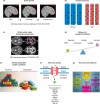Autism genetics: searching for specificity and convergence
- PMID: 22849751
- PMCID: PMC3491377
- DOI: 10.1186/gb4034
Autism genetics: searching for specificity and convergence
Abstract
Advances in genetics and genomics have improved our understanding of autism spectrum disorders. As many genes have been implicated, we look to points of convergence among these genes across biological systems to better understand and treat these disorders.
Figures


References
-
- Kanner L. Autistic disturbances of affective contact. Nerv Child 2. 1943. pp. 217–250. - PubMed
-
- American Psychiatric Association. Diagnostic and statistical manual of mental disorders. 4. text rev. American Psychiatric Association; 2000.
Publication types
MeSH terms
Grants and funding
LinkOut - more resources
Full Text Sources
Other Literature Sources
Research Materials

